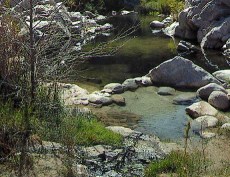It's no secret that the outdoors have become a popular choice to relieve some of the pressures people face in their daily lives. With a recent increase in visitation to the San Bernardino National Forest, firefighting personnel and land managers are growing increasingly concerned about the uptick in illegal campfires that have sprung up all over the forest. Year to date, forest officers have documented an over 150% increase, from 33 in 2019 to 87 in 2020.
Campfires built on the ground, or ground fires, are always prohibited on the San Bernardino National Forest because it can escape or reignite after a visitor extinguishes it and leaves. It's what one cannot see underground and control that begs a different story than one might intend. Often thinking it's been extinguished, fires can and have smoldered underground and reignited dead leaf matter or even tree roots. All it takes is a gust of wind to get it going again, where it can quickly grow into a full-blown wildfire threatening not only the forest's resources and private properties, but the people who live, work and play in the forest as well.
Under current fire restrictions, building, maintaining, attending or using a campfire is only allowed in fire rings provided by the Forest Service at open developed recreation sites, such as campgrounds and yellow post sites (Yellow post sites are dispersed individual campsites with a fire ring and picnic table; they are not attached to a campground).
The same goes for wood or charcoal barbecues, the prohibited use which has also increased, most notably in Lytle Creek and Mill Creek. Grilling with wood or charcoal is only allowed in barbecues provided by the Forest Service in open developed recreation sites, such as picnic areas, with a California Campfire Permit.
Those looking to grill or have a dispersed campfire do have an option. Portable stoves and campfire rings with a fuel shut-off valve that only burns gas, kerosene, jellied petroleum or pressurized liquid fuel are allowed. Users must have a California Campfire Permit and must be at least five feet away from vegetation.
California Campfire Permits are free and can be obtained online after watching a short, educational video from CAL FIRE.
A citation for violating fire restrictions prompts a mandatory court appearance. It is a federal offense punishable as a Class B misdemeanor, by a fine of not more than $5,000 for an individual or $10,000 for an organization, or imprisonment for not more than six (6) months or both.
"We know everyone enjoys having campfires while recreating outdoors," said San Bernardino National Forest Fire Chief Jaime Gamboa. "However, the public needs to be mindful of the conditions and where they are wanting to have campfires, in order to be safe."
Illegal campfires are on the rise
All posts are those of the individual authors and the owner
of this site does not endorse them. Content should be considered opinion
and not fact until verified independently.
| Subject | Author | Views | Posted |
|---|---|---|---|
| Rick | 2184 | June 13, 2020 12:53PM |
Sorry, only registered users may post in this forum.



